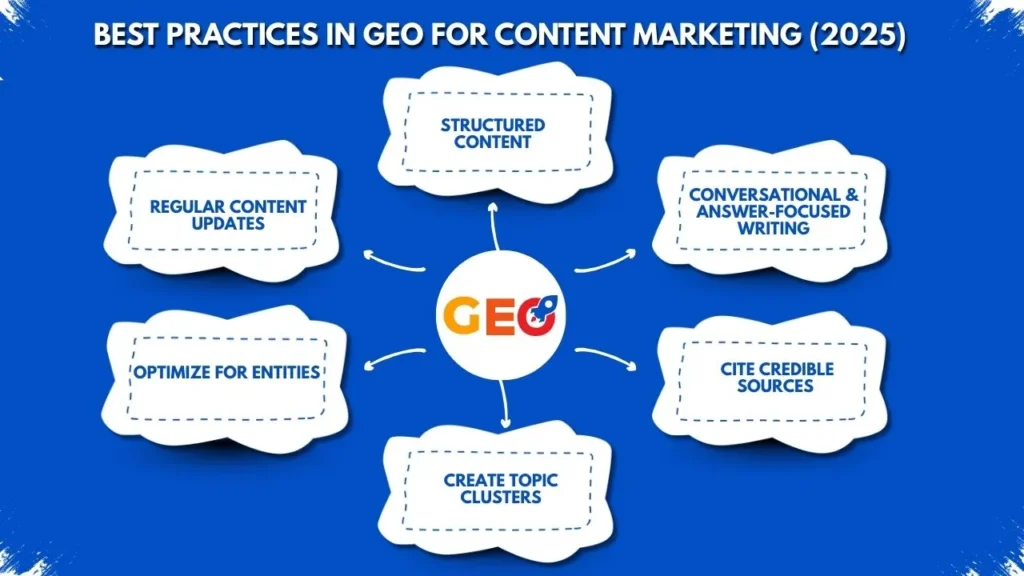Generative Engine Optimization, or GEO, is useful in this situation. GEO ensures your content is structured, clear, and authoritative, making it more likely to be selected as a top answer in AI-generated search results.
Key Takeaways
- The next step up from SEO is GEO (Generative Engine Optimization), which is made for search engines using artificial intelligence.
- GEO focuses on creating content that AI systems can understand, analyze, and select as authoritative answers.
- Best practices include using structured data, writing conversationally, citing credible sources, building topic clusters, and optimizing for entities.
- Updating and maintaining content regularly ensures AI recognizes it as accurate and trustworthy.
- Integrating GEO into your content marketing strategy positions your brand for higher visibility in the AI-driven search landscape.
What is GEO (Generative Engine Optimization)?
GEO, short for Generative Engine Optimization, is a modern approach to content optimization designed specifically for AI-powered search engines. Unlike traditional SEO, which focuses primarily on keywords, backlinks, and page authority, GEO emphasizes making your content easy for AI systems to understand, interpret, and reference.
At its core, GEO ensures that AI tools, like Google’s Search Generative Experience or chat-based assistants, can:
- Recognize your content as accurate and authoritative
- Pull relevant answers directly from your pages
- Make your content the first choice in search results produced by AI
Key aspects of GEO include:
- Structured Content: Using clear headings, bullet points, and schema markup so AI can easily parse your content.
- Conversational Tone: Writing in a natural, answer-focused style that aligns with how AI generates responses.
- Authority and Trustworthiness: Citing credible sources, studies, and expert opinions to boost AI confidence in your content.
- Entity Optimization: Ensuring concepts, brands, or terms are clearly defined so AI can differentiate them correctly.
“Generative engine optimization (GEO) is a technique for maximizing your content’s visibility in AI models. Unlike traditional SEO practices, which focus on ranking on SERPs, GEO is about optimizing content for visibility in generative AI engines.” — HubSpot Blog
Why GEO Matters for Content Marketing in 2025?
AI is revolutionizing how people find and use information. With the rise of tools like Google’s Search Generative Experience (SGE) and AI-powered assistants, users increasingly expect instant, accurate answers without visiting multiple websites. There are significant implications for content marketers from this change:
- Visibility Depends on AI Recognition
Content that is structured, clear, and authoritative is more likely to be selected by AI systems as the top answer. GEO ensures your content is formatted in a way that AI can understand and prioritize. - Content Longevity
AI-driven search engines prioritize current and accurate material. GEO encourages regular updates and precise information, helping your content stay relevant over time. - Competitive Advantage
An advantage is gained by early adopters of GEO best practices. While traditional SEO helps with human searches, GEO ensures your content appears in AI-generated responses, capturing a growing segment of search traffic. - Enhanced User Engagement
GEO emphasizes conversational, answer-focused writing. This not only improves AI recognition but also makes your content more engaging for readers, leading to higher trust and conversions.
By integrating GEO into your content marketing strategy, you position your brand as an authority in the AI-driven search landscape. Being the response that AI decides to provide is more important than simply ranking on page one these days.

GEO vs Traditional SEO – What’s Different?
| Feature | Traditional SEO | GEO (Generative Engine Optimization) |
| Focus | Keywords, backlinks, page authority | AI-friendly content, structured knowledge, entity optimization |
| Goal | Rank pages for human search queries | Be selected as the preferred answer in AI-generated results |
| Content Style | Keyword-driven, sometimes formal | Conversational, answer-focused, clear context |
| Data Emphasis | Links, domain authority, on-page SEO factors | Structured data, credible sources, entity clarity |
| Performance Metrics | Page rank, organic traffic | AI citations, featured snippets, answer box visibility |
| Update Frequency | Periodic SEO audits | Frequent updates for accuracy and relevance to AI |
Best Practices in GEO for Content Marketing
To implement GEO effectively, focus on structured content with clear headings and bullet points so AI can easily understand your content. Write conversationally and answer-focused to match how AI generates responses. Always cite credible sources to build authority, and link related content to create topic clusters for better context.
Also, optimize for entities by clearly defining brands, concepts, or terms, and update your content regularly to keep it accurate and relevant. Following these practices makes your content valuable for readers and more likely to be recognized by AI-powered search engines.
Want your content to stand out in AI-powered search results? TorontoSEOExpert offers GEO and content marketing optimization services to help your content get recognized by both AI and readers, boosting visibility and engagement.







